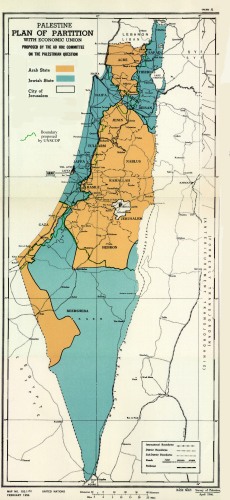Pages in Section 13

Battle for the Roads 1 - Jerusalem
ii. Massacres at refinery and Balad al Sheikh
iii. Battle for Jerusalem 1
iv. Ben Yehuda Street bombed
v. Jewish Agency bombed
vi. 1948 - Views of a Traffick Policeman
vii. Battle for the Roads 1 - Jerusalem
viii. Battle for the Roads 2 - Mishmar ha Emek
ix. Battle for the Roads 3- Deir Yassin
x. Haddassa Hospital Convoy
xi. Battle of the Roads 4- Gush Etzion
 Jerusalem remained the police's biggest headache. Because of the constant outrages there, the British administration had separated much of the Arab population from the Jewish in 1947, creating passes and checkpoints between population zones. Arabs and Jews no longer mixed and relied on their own shops for food supplies. All Jewish shops were supplied by wholesalers in the fertile coastal territories the UN had allocated to the Jews. All roads to Jerusalem from those areas, however had to wind their way through the steeply sloping rock-covered hills of the territory the UN had allocated to the Arabs.
Jerusalem remained the police's biggest headache. Because of the constant outrages there, the British administration had separated much of the Arab population from the Jewish in 1947, creating passes and checkpoints between population zones. Arabs and Jews no longer mixed and relied on their own shops for food supplies. All Jewish shops were supplied by wholesalers in the fertile coastal territories the UN had allocated to the Jews. All roads to Jerusalem from those areas, however had to wind their way through the steeply sloping rock-covered hills of the territory the UN had allocated to the Arabs.
Abd al-Qadir al-Husayni, leader of the Holy War Army,( See Fighting Forces in Palestine ) was not slow to exploit the situation. Having recruited a few hundred volunteers, many on day release from local villages, he organised a blockade of the most used road from Jerusalem to Tel Aviv. The rocks provided shelter for his men armed with rifles, home made hand grenades and stones. It was also easy enough to barricade the road by rolling rocks downhill. The Jews respondd by sending supplies in convoys of armoured lorries. The police offered to escort the armoured convoys but since the convoys contained weapons as well as food, Haganah refused the offer and used armed Haganah guards instead. All the polce authorty could do while they wre busy evacuating their British personne was to send a daily patrol car from Jerusalem to Tel Aviv and back to check the road was clear. That was completely ineffectual as the Arabs would allow the police vehicle to swan past but erect the barriers again to trap the Jewish convoys.
By March, since almost all Jewish armoured vehicles had been destroyed with many Haganah escorts killed or seriously wounded. David Ben-Gurion launched Operation Nachshon, created to take control of the territory allotted to Palestinian Jews and to protect the tiny Jewish population inside the Arab borders.
It was the first part of Plan Dalet, created for the takeover of Arab towns and villages inside Jewish territory after the British Mandate ended. However,with no organised period of hand-over to a UN Peace-keeping force by evacuating British forces, the police were in no position to prevent Jews from implementing itOpration Nachshon early, just as they could not prevent Arab attacks on Jewish convoys. Meanwhile the British army was still under orders not to interfre with fighting that occured as a result of the UN vote for partition.
So on April 6, in an effort to secure strategic positions, the Haganah and its strike force, the Palmach, attacked al-Qastal, a village two kilometers north of Deir Yassin overlooking the Jerusalem-Tel Aviv highway and open warfare engulfed Palestine.